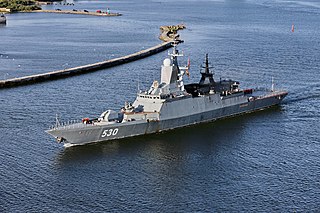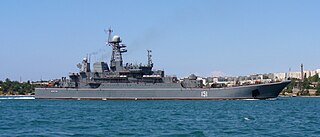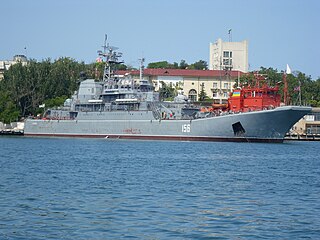
The Steregushchiy class, Russian designation Project 20380, is a class of corvettes being built for the Russian Navy. Designed by the Almaz Central Marine Design Bureau, subsequent vessels were built to an improved design, incorporating the Poliment-Redut SAM system. The ship full displacement and dimensions are large for a corvette, thus it is designated as a frigate by NATO. The Steregushchiy class has been further developed into the Gremyashchiy class and Project 20386 subclasses. The export variant is known as Project 20382 Tigr.

The Ropucha class, Soviet designation Project 775, is a class of landing ships built in Poland for the Soviet Navy. The ships were built in Poland in the Stocznia Północna shipyards in Gdańsk. Designed for beach landings, they can carry a 450-ton cargo. The ships have both bow- and stern-doors for loading and unloading vehicles, and the 630 square metres (6,800 sq ft) of vehicle deck stretches the length of the hull. Up to 25 armored personnel carriers can be embarked.

Russian cruiser Varyag, is the third ship of the Slava-class of guided missile cruisers built for the Soviet Navy now serving the Russian Navy.

Bystry was a Sovremenny-class destroyer of the Soviet and later Russian navy.

Novocherkassk is a Project 775 Ropucha II-class landing ship built in 1987 for the Soviet Navy and later inherited by the Russian Navy. The ship's namesake is Novocherkassk, a city in the Rostov Oblast, Russia.

Admiral Nevelskoy is a Project 775 Ropucha II-class landing ship built in 1982 for the Soviet Navy and later inherited by the Russian Navy. The ship's namesake is Admiral Nevelskoy, a Russian navigator from 1813 until 1876.

Kondopoga is a Project 775 Ropucha I-class landing ship built in 1976 for the Soviet Navy and later inherited by the Russian Navy. The ship's namesake is Kondopoga, a Russian town in Republic of Karelia, Russia.

Olenegorskiy Gornyak is a Project 775 Ropucha I-class landing ship built in 1976 for the Soviet Navy and later inherited by the Russian Navy. The ship's namesake is Olenegorsk Mining and Processing Plant, a Russian mining and processing plant.

Korolyov is a Project 775 Ropucha III-class landing ship built in 1990 for the Soviet Navy and later inherited by the Russian Navy. The ship's namesake is Korolyov, a Russian city in Moscow Oblast, Russia.

Azov is a Project 775 Ropucha III-class landing ship built in 1989 for the Soviet Navy and later inherited by the Russian Navy. The ship's namesake is Azov, a Russian town in Rostov Oblast, Russia.

Kaliningrad is a Project 775 Ropucha II-class landing ship built in 1984 for the Soviet Navy and later inherited by the Russian Navy. The ship's namesake is Kaliningrad, a Russian city in Kaliningrad Oblast, Russia.

Minsk is a Project 775 Ropucha II-class landing ship built in 1983 for the Soviet Navy and later inherited by the Russian Navy. The ship's namesake is Minsk, the capital city of Belarus.

Oslyabya is a Project 775 Ropucha II-class landing ship built in 1981 for the Soviet Navy and later inherited by the Russian Navy. The ship's namesake is Oslyabya, a Russian monk that fought in the Battle of Kulikovo.

Yamal is a Project 775 Ropucha II-class landing ship built in 1981 for the Soviet Navy and later inherited by the Russian Navy. The ship's namesake is Yamal Peninsula, a Russian okrug, Yamalo-Nenets Autonomous Okrug, Siberia, Russia.

Alexandr Shabalin is a Project 775 Ropucha II-class landing ship built in 1985 for the Soviet Navy and later inherited by the Russian Navy. The ship's namesake is Aleksandr Shabalin, a Soviet counter admiral which was awarded the Hero of the Soviet Union during World War II.

Georgiy Pobedonosets is a Project 775 Ropucha II-class landing ship built in 1985 for the Soviet Navy and later inherited by the Russian Navy. The ship's namesake is Georgiy Pobedonosets, a christian saint and martyr.

Konstantin Olshanskiy is a Project 775 Ropucha II-class landing ship built in 1985 for the Soviet Navy and later transferred to the Ukrainian Navy. The ship's namesake is Konstantin Olshanskiy, a Ukrainian senior lieutenant of the Soviet naval infantry whom was awarded the Hero of the Soviet Union during World War II.

Alexandr Otrakovskiy is a Project 775 Ropucha II-class landing ship built in 1977 for the Soviet Navy and later inherited by the Russian Navy. The ship's namesake is Alexander Ivanovich Otrakovsky, a Russian major general of the Red Banner Northern Fleet whom was awarded the Hero of the Russian Federation in 2000.

Nikolay Vilkov is a Project 1171 Alligator IV-class landing ship built in 1974 for the Soviet Navy and later inherited by the Russian Navy. The ship's namesake is Nikolai Alexandrovich Vilkov, a Russian sailor whom was awarded the Hero of the Soviet Union during World War II.





















